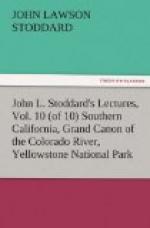[Illustration: THE EARTH-GULF OF ARIZONA.]
[Illustration: A PORTION OF THE GULF.]
[Illustration: “A VAST, INCOMPARABLE VOID.”]
As brain grew steadier and vision clearer, I saw, directly opposite, the other side of the Canon thirteen miles away. It was a mountain wall, a mile in height, extending to the right and left as far as the eye could reach; and since the cliff upon which I was standing was its counterpart, it seemed to me as if these parallel banks were once the shore-lines of a vanished sea. Between them lay a vast, incomparable void, two hundred miles in length, presenting an unbroken panorama to the east and west until the gaze could follow it no farther. Try to conceive what these dimensions mean by realizing that a strip of the State of Massachusetts, thirteen miles in width, and reaching from Boston to Albany, could be laid as a covering over this Canon, from one end to the other; and that if the entire range of the White Mountains were flung into it, the monstrous pit would still remain comparatively empty! Even now it is by no means without contents; for, as I gazed with awe and wonder into its colossal area, I seemed to be looking down upon a colored relief-map of the mountain systems of the continent. It is not strictly one canon, but a labyrinth of canons, in many of which the whole Yosemite could be packed away and lost. Thus one of them, the Marble Canon, is of itself more than three thousand feet deep and sixty-six miles long. In every direction I beheld below me a tangled skein of mountain ranges, thousands of feet in height, which the Grand Canon’s walls enclosed, as if it were a huge sarcophagus, holding the skeleton of an infant world. It is evident, therefore, that all the other canons of our globe are, in comparison with this, what pygmies are to a giant, and that the name Grand Canon, which is often used to designate some relatively insignificant ravine, should be in truth applied only to the stupendous earth-gulf of Arizona.
[Illustration: A SECTION OF THE LABYRINTH.]
[Illustration: MOUNT AYER.]
At length, I began to try to separate and identify some of these formations. Directly in the foreground, a savage looking mountain reared its splintered head from the abyss, and stood defiantly confronting me, six thousand feet above the Canon’s floor. Though practically inaccessible to the average tourist, this has been climbed, and is named Mount Ayer, after Mrs. Edward Ayer, the first woman who ever descended into the Canon to the river’s edge. Beyond this, other mountains rise from the gulf, many of which resemble the Step Pyramid at Sakhara, one of the oldest of the royal sepulchres beside the Nile. But so immeasurably vaster are the pyramids of this Canon than any work of man, that had the tombs of the Pharaohs been placed beside them, I could not have discovered them without a field-glass. Some of these grand constructions stand alone, while others are in pairs;




